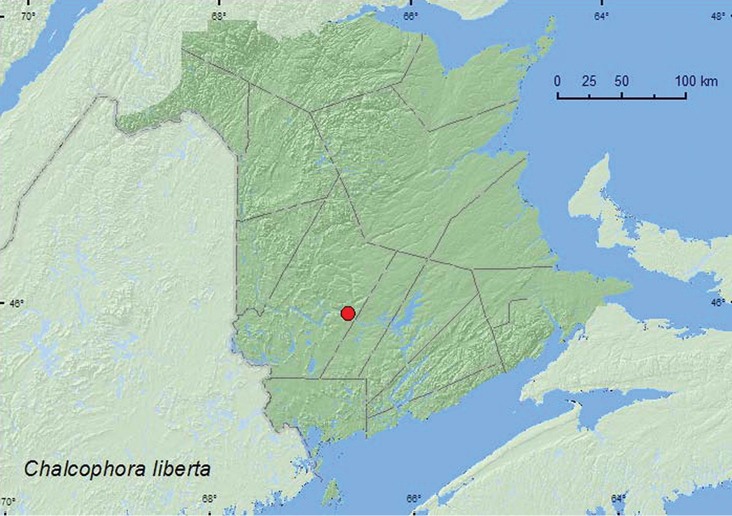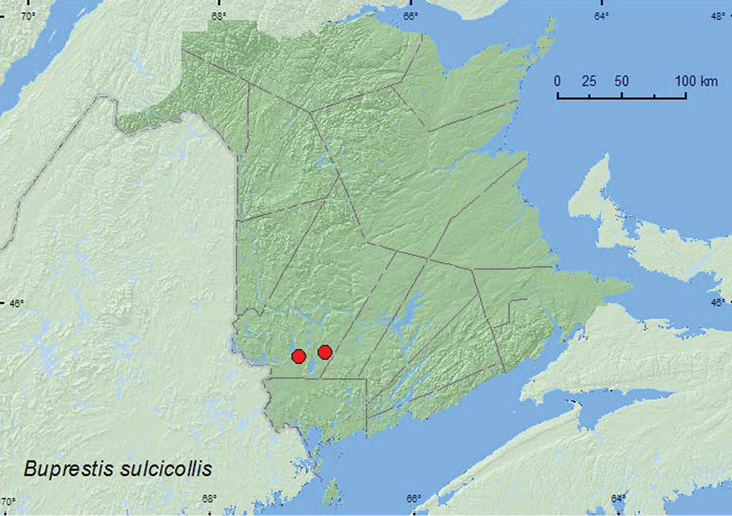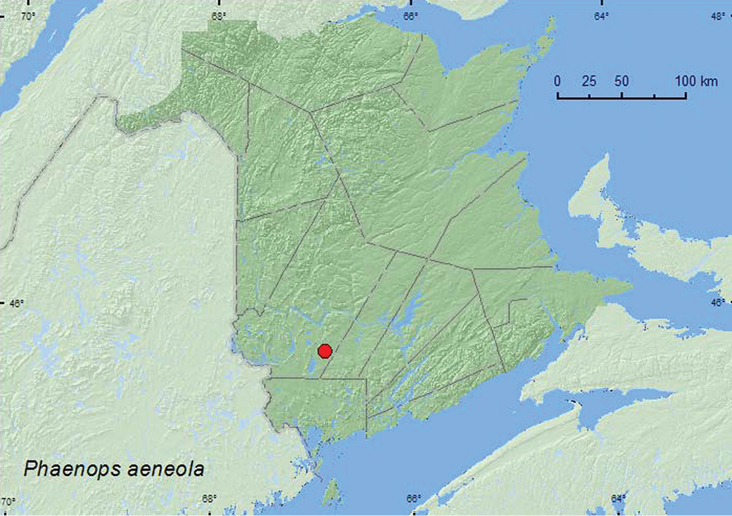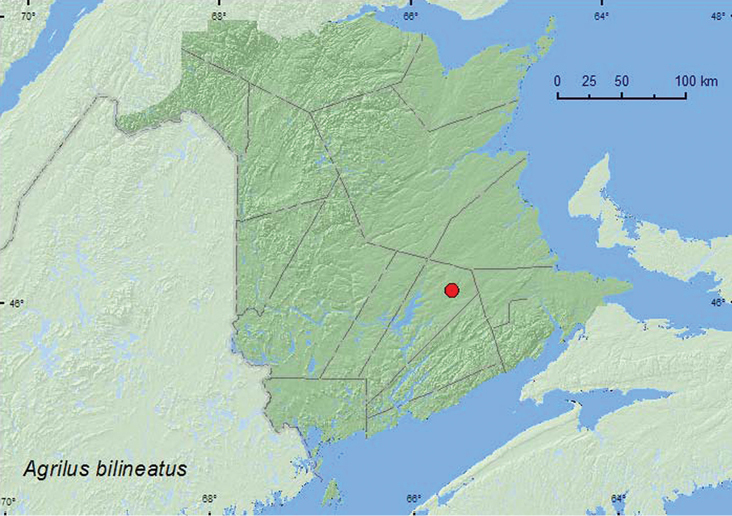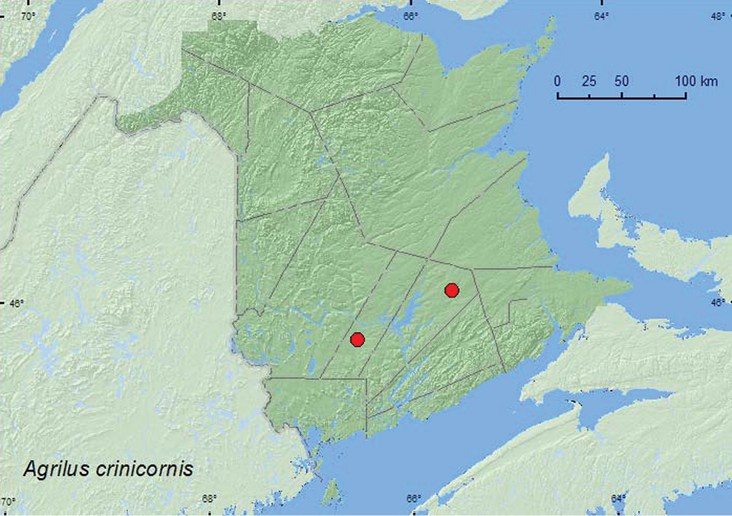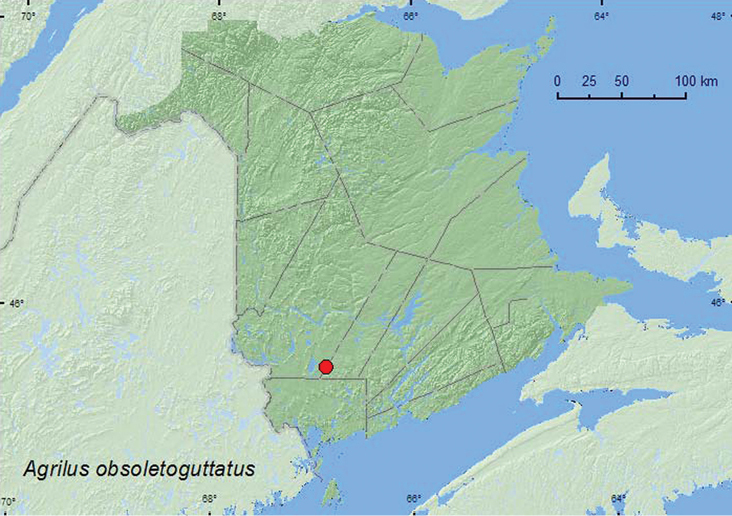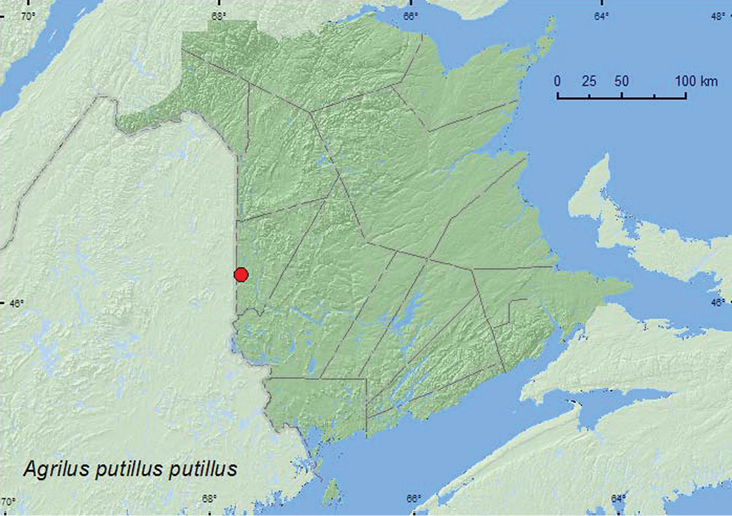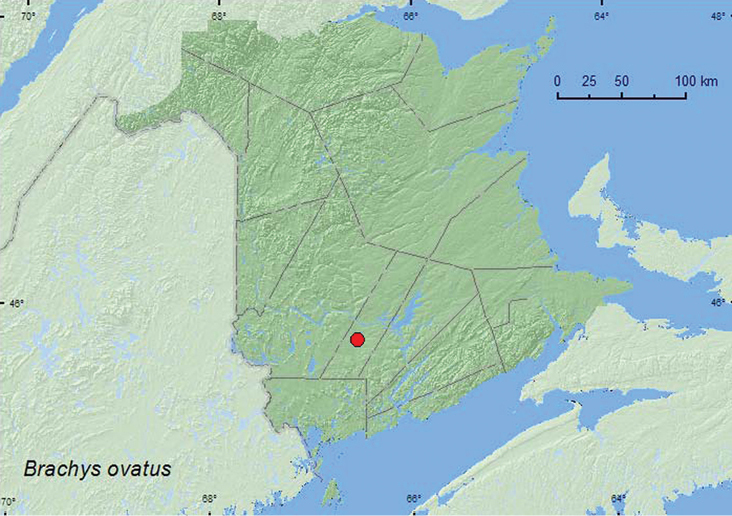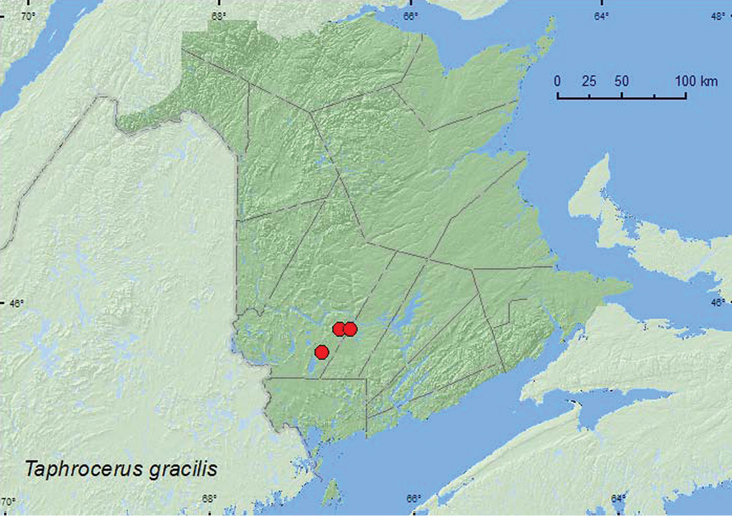






(C) 2012 Reginald P. Webster. This is an open access article distributed under the terms of the Creative Commons Attribution License 3.0 (CC-BY), which permits unrestricted use, distribution, and reproduction in any medium, provided the original author and source are credited.
For reference, use of the paginated PDF or printed version of this article is recommended.
Nine species of Buprestidae; Agrilus bilineatus (Weber), Agrilus crinicornis Horn, Agrilus obsoletoguttatus Gory, Agrilus putillus putillus Say, Brachys ovatus (Weber), Buprestis sulcicollis (LeConte), Chalcophora liberta (Germar), Phaenops aeneola (Melsheimer), and Taphrocerus gracilis (Say) are newly recorded for New Brunswick, Canada. Agrilus bilineatus, A. crinicornis, A. obsoletoguttatus, and B. ovatus are also newly reported for the Maritime provinces. Lindgren 12-funnel traps do not appear to be an effective tool for sampling the Bupresidae. Collection, habitat notes, and distribution maps are presented for each species.
Buprestidae, new records, Canada, New Brunswick
The following records are based on specimens collected during a general survey by the first author to document the Coleoptera fauna of New Brunswick and from by-catch samples obtained during a study to develop a general attractant for the detection of Cerambycidae. Additional provincial records were obtained from specimens contained in the collection belonging to Natural Resources Canada, Canadian Forest Service - Atlantic Forestry Centre, Fredericton, New Brunswick.
Collection methodsMost specimens were collected by sweeping foliage or hand picking from host plants. A few specimens were captured in Lindgren 12-funnel traps during a study to develop a general attractant for the detection of invasive species of Cerambycidae. See
Males of some species of Buprestidae (most Agrilus species) were dissected to confirm their identity. The genital structures were dehydrated in absolute alcohol and mounted in Canada balsam on celluloid microslides or glued on cards and pinned with the specimens from which they originated.
DistributionDistribution maps, created using ArcMap and ArcGIS, are presented for each species in New Brunswick. Every species is cited with current distribution in Canada and Alaska, using abbreviations for the state, provinces, and territories. New records for New Brunswick are indicated in bold under Distribution in Canada and Alaska. The following abbreviations are used in the text:
| AK | Alaska | MB | Manitoba |
| YT | Yukon Territory | ON | Ontario |
| NT | Northwest Territories | QC | Quebec |
| NU | Nunavut | NB | New Brunswick |
| BC | British Columbia | PE | Prince Edward Island |
| AB | Alberta | NS | Nova Scotia |
| SK | Saskatchewan | NF & LB | Newfoundland and Labrador* |
*Newfoundland and Labrador are each treated separately under the current Distribution in Canada and Alaska.
Acronyms of collections examined or where specimens reside referred to in this study are as follows:
AFC Atlantic Forestry Centre, Natural Resources Canada, Canadian Forest Service, Fredericton, New Brunswick, Canada
CNC Canadian National Collection of Insects, Arachnids and Nematodes, Agriculture and Agri-Food Canada, Ottawa, Ontario, Canada
NBM New Brunswick Museum, Saint John, New Brunswick, Canada
RWC Reginald Webster Collection, Charters Settlement, New Brunswick, Canada
Results Species accountsAll records below are species newly recorded for New Brunswick, Canada. Species followed by ** are newly recorded from the Maritime provinces of Canada.
The classification of the Buprestidae follows
Species of Buprestidae recorded from New Brunswick, Canada.
| Family Buprestidae Leach |
| Subfamily Chrysochroinae Laporte |
| Tribe Chrysochroini Laporte |
| Chalcophora fortis LeConte |
| Chalcophora liberta (Germar)* |
| Chalcophora virginiensis (Drury) |
| Poecilonota cyanipes (Say) |
| Tribe Dicercini Gistel |
| Dicerca caudata LeConte |
| Dicerca divaricata (Say) |
| Dicerca lugubris LeConte |
| Dicerca tenebrica (Kirby) |
| Dicerca tenebrosa tenebrosa (Kirby) |
| Dicerca tuberculata (Laporte & Gory) |
| Subfamily Buprestinae Leach |
| Tribe Buprestini Leach |
| Buprestis fasciata Fabricius |
| Buprestis maculativentris Say |
| Buprestis striata Fabricius |
| Buprestis sulcicollis (LeConte)* |
| Tribe Anthaxiini Gory & Laporte |
| Anthaxia inornata (Randall) |
| Anthaxia quercata (Fabricius) |
| Tribe Melanophilini Bedel |
| Melanophila acuminata (DeGeer) |
| Phaenops abies (Champlain & Knull) |
| Phaenops aeneola (Melsheimer)* |
| Phaenops drummondi (Kirby) |
| Phaenops fulvoguttatus (Harris) |
| Tribe Chrysobothrini Gory & Laporte |
| Chrysobothris dentipes (Germar) |
| Chrysobothris femorata (Olivier) |
| Chrysobothris harrisi Hentz |
| Chrysobothris neopusilla Fisher |
| Chrysobothris pusilla Gory & Laporte |
| Chrysobothris rotundicollis Gory & Laporte |
| Chrysobothris scabripennis Gory & Laporte |
| Chrysobothris sexsignata Say |
| Chrysobothris trinervia Kirby |
| Chrysobothris verdigripennis Frost |
| Subfamily Agrilinae Laporte |
| Tribe Coraebini Bedel |
| Eupristocerus cogitans (Weber) |
| Tribe Agrilini Laporte |
| Agrilus anxius Gory |
| Agrilus arcuatus (Say) |
| Agrilus bilineatus (Weber)** |
| Agrilus criddlei Frost |
| Agrilus crinicornis Horn** |
| Agrilus cuprescens (Ménétries) |
| Agrilus granulatus liragus Barter & Brown |
| Agrilus obsoletoguttatus Gory** |
| Agrilus pensus Horn |
| Agrilus politus (Say) |
| Agrilus putillus putillus Say** |
| Agrilus ruficollis (Fabricius) |
| Agrilus sayi Saunders |
| Tribe Trachyini Laporte |
| Brachys aerosus (Melsheimer) |
| Brachys ovatus (Weber)** |
| Taphrocerus gracilis (Say)* |
Notes: *New to province, **New to Maritime provinces.
Nine species of Buprestidae are newly recorded for New Brunswick, Canada. Among these, Agrilus bilineatus (Weber), Agrilus crinicornis Horn, Agrilus obsoletoguttatus Gory, and Brachys ovatus (Weber) are also new for the Maritime provinces (New Brunswick, Nova Scotia, Prince Edward Island). Only six specimens of two of the nine species reported here were captured in Lindgren 12-funnel traps during a study to develop a general attractant for the detection of invasive species of Cerambycidae. These traps mimic tree trunks and are often effective for sampling species of Coleoptera that live in microhabitats associated with standing trees (
New Brunswick, York Co., Fredericton, 16.VIII.1988, G. J. Crain (1, AFC).
Collection localities in New Brunswick, Canada of Chalcophora liberta.
No habitat data were associated with this specimen. Larvae of this species have been reported from red pine (Pinus resinosa Ait.) and white pine (Pinus strobus L.) (
MB, ON, QC, NB, PE (
New Brunswick, York Co., 3.5 km S jct. Hwy 3 & 4 near Davis Brook, 11.VI.1998, R. P. Webster, on white pine log (1, RWC); 15 km W of Tracy off Rt. 645, 45.6837°N, 66.8809°W, 10.VI.2007, R. P. Webster, clear-cut (old red pine forest), on red pine stump (1, RWC).
Collection localities in New Brunswick, Canada of Buprestis sulcicollis.
Larvae have been reported from pitch pine (Pinus rigida Mill.) and white pine (
NT, AB, MB, ON, QC, NB, NS, NF (
New Brunswick, York Co., 15 km W of Tracy off Rt. 645, 45.6848°N, 66.8821°W, 4–11.VIII.2009, R. Webster & M.-A. Giguère, old red pine forest, Lindgren funnel trap (1, AFC); same locality and forest type, emgd. 3–7.V.2010, C. Hughes, reared from small branches of fallen red pine (3, AFC, RWC); same locality and forest type but 27.VII–10.VIII.2010, R. Webster & C. Hughes, Lindgren funnel trap (1, AFC).
Collection localities in New Brunswick, Canada of Phaenops aeneola.<br/>
Larvae of this species have been reported from red pine and Virginia pine (Pinus virginiana Mill.) (
ON, QC, NB, PE (
New Brunswick, Queens Co., Cranberry Lake P.N.A. (Protected Natural Area) 46.1125°N, 65.6075°W, 14.VIII.2009, M.-A. Giguère & R. Webster, red oak forest, on foliage of red oak sapling (1, RWC); same locality data and forest type, 29.VI–7.VII.2011, M. Roy & V. Webster, Lindgren forest trap in forest canopy (4, AFC, NBM, RWC).
Collection localities in New Brunswick, Canada of Agrilus bilineatus.
Larvae of A. bilineatus have been reported from a variety of Quercus sp., including our native red oak (Quercus rubra L.) (
MB, ON, QC, NB (
New Brunswick, Queens Co., Cranberry Lake P.N.A, 46.1125°N, 65.6075°W, 18.VI.2009, 25.VI.2009, R. Webster & M.-A. Giguère, old red oak forest, on foliage of red oak (3, AFC). Sunbury Co., Burton near Sunpoke Lake, 45.7658°N, 66.5546°W, 20.VI.2007, R. P. Webster, red oak and red maple forest, on foliage of Quercus rubra (9, RWC).
Collection localities in New Brunswick, Canada of Agrilus crinicornis.
Larval hosts include Diospyros virginiana L., American beech (Fagus grandifolia Ehrh.), honey locust (Gleditsia triacanthos L.), and white oak (Quercus alba L.) (
ON, QC, NB (
New Brunswick, Sunbury Co., Little Lake Rd., 10.VII.1958 (E. A. Rubridge), on red oak, 58-0795 (2, AFC). (Specimens determined by D.E. Bright, 1981).
Collection localities in New Brunswick, Canada of Agrilus obsoletoguttatus.
Larval hosts of A. obsoletoguttatus reported by
ON, QC, NB (
New Brunswick, Carleton Co., Jackson Falls, Bell Forest, 46.2200°N, 67.7231°W, 8.VII.2008, R. P. Webster, Rich Appalachian hardwood forest, m.v. light (1, RWC).
Collection localities in New Brunswick, Canada of Agrilus putillus putillus.
Larval hosts include sugar maple (Acer saccharum Marsh.), Norway maple (A. platanoides L.), and honey locust (
ON, QC, NB, PE(
New Brunswick, Sunbury Co., Burton near Sunpoke Lake, 45.7659°N, 66.5563°W, 28.VII.2007, R. P. Webster, margin of red oak stand near lakeshore, on foliage of Quercus rubra (1, RWC).
Collection localities in New Brunswick, Canada of Brachys ovatus.
Hosts include avariety of Quercus sp., including red oak (
ON, QC, NB (
New Brunswick, York Co., Charters Settlement, 45.8428°N, 66.7279°W, 20.IV.2005, R. P. Webster, mixed forest, small sedge marsh, in moist grass litter & sphagnum (1, RWC); same locality and collector but 45.8430°N, 66.6275°W, 17.VI.2007, regenerating mixed forest, sweeping foliage of Carex species in small marshy area (1, RWC); 17 km W of Tracy off Rt. 645, 45.6816°N, 66.9060°W, 2.VII.2008, R. P. Webster, red pine forest, marshy area in roadside ditch, sweeping (1, RWC).
Collection localities in New Brunswick, Canada of Taphrocerus gracilis.
Larval hosts include beak-rush (Rhynchospora corniculata (Lam.)) and bulrush (Schoenoplectus fluviatilis (Torr.)) (
AB, SK, MB, ON, QC, NB, NS (
We thank Caroline Simpson (AFC) for editing this manuscript and an anonymous reviewer for helpful suggestions that improved this manuscript. Jon Sweeney is thanked for providing comments on an earlier version; Serge Laplante and Anthony Davies (Agriculture and Agri-Food Canada (CNC), Ottawa) for determining specimens and other invaluable assistance; and Nichole Brawn, Katie Burgess, Marie-Andrée Giguère, Nancy Harn, Cory Hughes, Colin MacKay, Wayne MacKay, Jessica Price, Michelle Roy, and Vincent Webster for technical assistance and collecting specimens. Natural Resources Canada, Canadian Forest Service; the Canadian Food Inspection Agency; and the USDA APHIS are thanked for funding the study on early detection of invasive cerambycids, which provided specimens collected in Lindgren funnel traps. We thank the New Brunswick Environmental Trust Fund and New Brunswick Wildlife Trust Fund for funding various insect surveys over the past 7 years, the Meduxnekeag River Association for permission to sample beetles at the Meduxnekeag Valley Nature Preserve (which includes the Bell Forest), and the New Brunswick Department of Natural Resources (Fish and Wildlife Branch) for issuing permits for sampling in the Protected Natural Areas.
